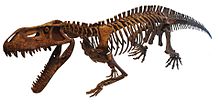| Suchians Temporal range: Early Triassic - Recent,
| |
|---|---|

| |
| Paratypothorax andressorum, an aetosaur | |

| |
| Prestosuchus chiniquensis, an early loricatan | |
| Scientific classification | |
| Domain: | Eukaryota |
| Kingdom: | Animalia |
| Phylum: | Chordata |
| Class: | Reptilia |
| Clade: | Archosauria |
| Clade: | Pseudosuchia |
| Clade: | Suchia Krebs, 1974 |
| Subgroups | |
Suchia is a clade of archosaurs containing the majority of pseudosuchians (crocodilians and their extinct relatives). It was defined as the least inclusive clade containing Aetosaurus ferratus, Rauisuchus tiradentes, Prestosuchus chiniquensis, and Crocodylus niloticus (the living Nile crocodile) by Nesbitt (2011).[1] Generally the only pseudosuchian group which is omitted from Suchia is the family Ornithosuchidae, although at least one analysis classifies ornithosuchids as close relatives of erpetosuchids (which are usually considered suchians) and aetosaurs (which are suchians by definition of the group).[2] Phytosaurs are also excluded from Suchia, although it is not certain whether they qualify as pseudosuchians in the first place.[1][3]
There is some controversy over which traits, if any, can be used to distinguish suchians from non-suchian archosaurs. Anatomical features which evolve at the base of a group, and can thus be used to characterize the group, are known as synapomorphies. The two most comprehensive recent studies on archosaur relationships, Nesbitt (2011)[1] and Ezcurra (2016),[3] each came to different conclusions on what synapomorphies characterize Suchia. Nevertheless, they did agree on one trait that likely qualified as a synapomorphy of Suchia: a calcaneal tuber which was significantly wider than it was tall.
- ^ a b c Cite error: The named reference
nesbitt2011was invoked but never defined (see the help page). - ^ Ezcurra, Martín D.; Fiorelli, Lucas E.; Martinelli, Agustín G.; Rocher, Sebastián; Baczko, M. Belén von; Ezpeleta, Miguel; Taborda, Jeremías R. A.; Hechenleitner, E. Martín; Trotteyn, M. Jimena (11 September 2017). "Deep faunistic turnovers preceded the rise of dinosaurs in southwestern Pangaea". Nature Ecology & Evolution. 1 (10): 1477–1483. Bibcode:2017NatEE...1.1477E. doi:10.1038/s41559-017-0305-5. hdl:11336/41466. ISSN 2397-334X. PMID 29185518. S2CID 10007967.
- ^ a b Ezcurra, Martín D. (2016-04-28). "The phylogenetic relationships of basal archosauromorphs, with an emphasis on the systematics of proterosuchian archosauriforms". PeerJ. 4: e1778. doi:10.7717/peerj.1778. ISSN 2167-8359. PMC 4860341. PMID 27162705.